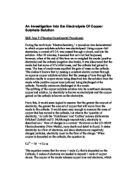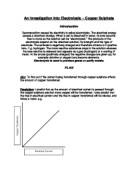The ‘Electrochemistry’ topic notes, and the CD-Rom ‘The Times GCSE Chemistry’ explain that when a current of 1 amp (ampere) passes for the time of 1 second, then 1 coulomb of electric charge flows. This means the quantity of electricity can be measured in terms of electric charge. Varying the current can control the size of the charge, or by adjusting the time the electricity passes. The equation:
Charge (C) = Current (A) x Time (sec.)
From a practical point of view, there wouldn’t seem to be anything to choose between adjusting the time, and varying the current in order to change the electrical charge. In the electrolysis of any aqueous solution, this wouldn’t be necessary, as it was found in such cases that if the current was too high, the material plated on the cathode didn’t deposit very well. In these cases, currents of no more than 1 amp are advised. In the experiment I will perform, these conditions aren’t too important, as electrical charge will be varied by keeping the duration constant, but changing the current. The current will be controlled by a rheostat, which can be used to obtain a variety of current values, and in each case to keep the current constant. Depending on the amount of time I will have to carry out my procedure, I shall use the current values of 0.2A, 0.4A, 0.6A, 0.8A and 1.0A. I will have the current flowing through my circuit for about 5 minutes per time, and then allow 2 minutes to set up the next stage of the experiment, and 1 – 2 minutes to clean, and re-weigh the electrodes. An alternative method is of course to keep the current set at a constant, and to change the times. i.e. 0.2 Amps for 5 mins, 0.2 amps for 10 mins…etc. I would consider using this method if we had 2 double periods to do the experiment, but as we only have 1, it would be impossible to accomplish good results in such a limited amount of time. The apparatus I shall use is labelled overleaf:
During my experiment, it was considered that the following factors could affect the deposition of Copper metal on the cathode.
1. Time
2. Current
3. Temperature
4. Molarity/Concentration of Solution
5. Quantity of Solution
6. Size of Electrodes
7. Distance between the electrodes
8. The surface of the electrodes
I must strive to try to keep these variables from affecting my results. One way is to thoroughly clean all equipment after each use.
A good range and number of electrical charges to use could be achieved by having times of 5 minutes of the current flowing, and currents ranging from 0.2A to 1A. Here is a table to show how I will carry out the investigation:
Current / Amperes Time / Seconds Electrical Charge /Coulombs
0.2 300 (5mins) 60
0.4 300 (5mins) 120
0.6 300 (5mins) 180
0.8 300 (5mins) 240
1.0 300 (5mins) 300
Whilst studying ‘Electrochemistry,’ it was realised that:
‘1 mole of electrons is equal to a 96,500 C electrical charge.’
The figure of 96,500 C is referred to now as a faraday (F), which was named after a scientist, Michael Faraday (1791-1867), who researched the topic in its primary stages.
Using this evidence, we can now predict how much copper will be formed for the given currents above. Using Cu2+ + 2e- → Cu (s) and the formula Charge (C) = Current (A) x Time (sec.). Here are my predictions:
60 C = (60÷96500) = 0.0006218 mol e-
2 mol e- produce 1 mol Cu
0.0006218 mol e- will produce (0.5 x 0.0006218) = 0.0003109 mol Cu.
Ar (Cu) = 64
0.0003109 mol Cu = (0.0003109 x 64) = 0.020g (to 3.d.p)
Doing similar calculations as those shown above, I can put my predictions into a simpler, easier format. These are the predicted masses of copper arrived at:
Electric charge / C Predicted mass of Copper / g
60 0.02
120 0.04
180 0.06
240 0.08
300 0.10
The above data can be plotted in a graph (see overleaf. ‘Predicted Mass of Copper Against Electric Change.’)
The fact that the graph is a straight line through the origin (where there is no charge or mass of copper) means that it can be predicted that:
‘The mass of copper deposited during the electrolysis of copper sulphate solution is directly in proportion to the electrical charge used.’
Research from Michael Faraday first discovered this quantitative prediction. It’s known as Faraday’s first law of electrolysis. It reads exactly:
“The mass of any element deposited during electrolysis is directly proportional to the number of coulombs of electricity passed”
Further research showed that Faraday’s first law could be explained in the following way:
“If the current is doubled, the number of electrons flowing along the wire in a given time is also doubled. Hence the number of ions reacting at the electrodes is also doubled and so the masses of substances are doubled. Also, if the current is allowed to flow for twice as long, the total number of ions discharged and hence the masses of substances liberated are again doubled. Thus the masses liberated are proportional to the current and time, i.e. to the quantity of electricity.
Whilst studying ‘electrochemistry,’ we saw a series of video clips, including one from the CD-ROM ‘Electrochemistry.’ Here, a range of illustrations were shown using molten lead bromide as an example. Further research led me to an illustration in ‘The Science Co-ordination Group’s’ book ‘Key Stage 3 Science.’ There was a useful diagram here, which I have enclosed beneath:
Below is the method I will use for my experiment:
- Weigh the electrodes before starting
- In a fume cupboard, I will set up the apparatus I provided between pages 2 and 3;
- Switch on the current and set up at 0.2A using the variable resistor. Begin the timing for 5 minutes as soon as the current is switched on, using a stopwatch;
- During the electrolysis, observe the ammeter and any fluctuations in a current should be adjusted to 0.2A using the variable resistor;
- After 5 minutes, switch off the current, and having removed the electrodes from the solution, rinse the foil carefully to remove solution in distilled water taking care not to wash off the deposited copper. Then, rinse the foil with propanone to remove any distilled water. Complete drying process with hair dryer.
- Weigh the electrodes to see how much copper has been formed and lost at the cathode and anode respectively;
- Set up the apparatus again, using new copper sulphate solution, that is the same amount as before (probably about 200-300cm³ depending on resources available) and repeat stages 1) to 6), but this time, increase the current to 0.4A for the electrolysis;
-
During this next electrolysis, plot the data obtained (using Charge (C) = Current (A) x Time (sec.) to give the electrical charge on the horizontal axis, and plot mass of copper deposited on the vertical axis. As the investigation progresses, it will then be able to be seen if any anomalous results are encountered, and if so if I will need to repeat them whilst the apparatus is still set up;
- Repeat 7) and 8) for currents of 0.6A, 0.8A, and 1Amp.
Review Of Skill P
Having had the opportunity to read over my documents for the final time before undertaking the experiment, I have decided to make one slight change to my method. In part 7) on p6, I stated that I’d probably use 200-300cm³ of copper sulphate solution. Having now been briefed fully on what equipment I shall have at my disposal, I will now use just 50 cm³ of solution. Apart from this small but important change, I don’t think I need to make any more change to my plan.







